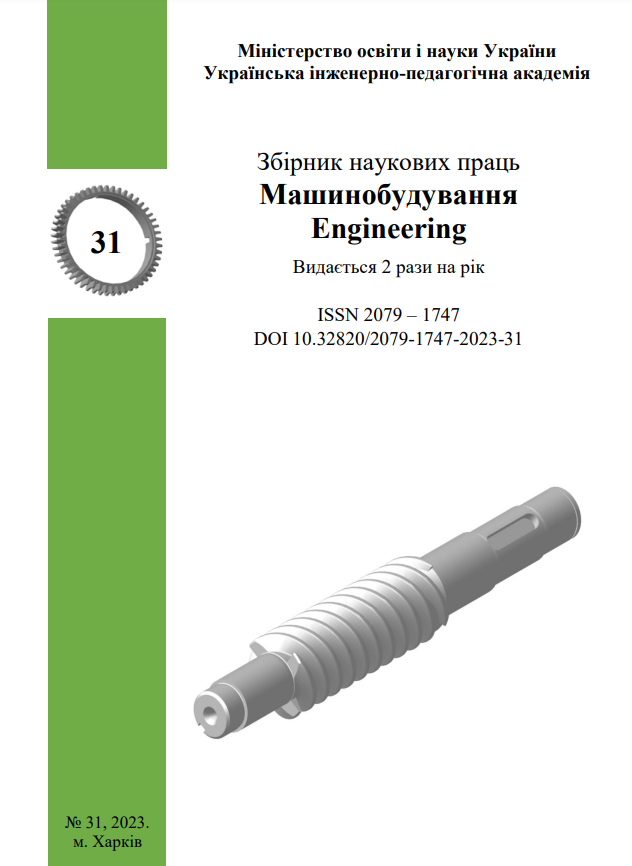ДІАГНОСТИКА І ПРОГНОЗУВАННЯ ЗНОСУ РІЗАЛЬНОГО ІНСТРУМЕНТА ПРИ ОБРОБЦІ НА ВЕРСТАТАХ З ЧПК
Анотація
DOI: https://doi.org/10.32820/2079-1747-2023-31-21-32
У статті розглядається один із варіантів вирішення одні з найважливіших проблем
обробки матеріалів різанням – прогнозування ресурсу різального лезового інструменту та
розробки на цій основі нового методу діагностування його технічного стану, що й запобігло
актуальності представленого у статті матеріалу. При цьому під ресурсом розуміється період
стійкості інструменту між переточуванням, тому що тривалість експлуатації інструменту, що
не вимагає перезаточування, найбільш просто піддається автоматичному контролю.
Метою досліджень, результати яких викладені в цій статті, є створення методу
прогнозування ресурсу різального інструменту, що ґрунтується на безперервному контролі в
процесі різання величини тиску звуку, що супроводжує обробку різанням.
У процесі досліджень було використано методи: системного аналізу, теорії різання,
теорії коливань та ідентифікації, що виконується методом випадкового пошуку. Розглянуто
динамічну поведінку металообробної технологічної системи при зношуванні ріжучого
інструменту.
В результаті проведених досліджень розроблено метод прогнозування ресурсу
ріжучого інструменту, що ґрунтується на ідентифікації параметрів прогнозної моделі за
результатами безперервного контролю сигналів віброакустичної емісії (ВАЕ) за величиною,
що супроводжує процес різання. Причому модель складена таким чином, що шуканий ресурс
включений до її математичної структури, що дозволяє виключити використання під час
прогнозування статистично ненадійних критеріальних параметрів, що описують граничний
стан інструменту.
Розроблено модель прогнозування технічного стану технологічної системи, що
дозволяє оцінювати ресурс як інструменту, і технологічної системи загалом. Знання ресурсу
технологічної системи забезпечує перехід до адаптивного управління її функціонуванням і
виключає цим непередбачені зупинки заміну інструменту, ремонт верстата і зводить до
мінімуму ризик появи браку обробленої деталі. Розроблений автоматизований прогнознодіагностичний комплекс забезпечує використання запропонованої прогнозної моделі у
практику обробки широкого кола матеріалів, що у результаті вирішує важливе науковопрактичне завдання підвищення ефективності процесу різання.
Завантаження
Посилання
Zaloga, VO & Vnukov, JM 2010, Znoshuvannja і stіjkіst' rіzal'nih lezovih іnstrumentіv, [Wear resistance and cutting blade tools], Sums'kij derzhavnij unіversitet, Sumi.
Zaloha, VA & Zinchenko, RN 2008, ‘Doslidzhennia mozhlyvosti zastosuvannia metodu diahnostyky akustychnoi emisii v chystove tochinnia tytanovoho splavu’, [Investigation of the possibility to apply the method of acoustic emission diagnostics in titanium alloy finishing turning], Vesnyk KumDU. Seriia Tekhnichni nauky, no 4, Pp. 118-125.
Rumbeshta, VO 2000, Systemy keruvannia yakistiu vyhotovlennia vyrobiv, [Quality management systems for manufacturing products: a course of lectures], NTUU «KPI», Kiev.
Ribalko, AP, Lyshchenko, NV & Larshyn, VP 2015, ‘Cystemi tekhnolohycheskoi dyahnostyky y adaptyvnoho upravlenyia dlia stankov s ChPU’, [Process diagnostics and adaptive control systems for CNC machines], Vysoki tekhnolohii v mashynobuduvanni, no 1, Pp. 150–161.
Barton, J & Reuben, B 1996, ‘Tool - wear monitoring by optical techniques’, Materials World, no 4 (3), Pp. 131-132.
Chen, JC & Black, JT 1997, ‘A fuzzy-nets in-process (FNIP) system for tool-breakage monitoring in end-milling operations’, International Journal of Machine Tools and Manufacture, no 37, Pp. 783-800.
Chen, JC, Chen, WL 1999, ‘A tool breakage Detection system using an Accelerometer sensor’, Journal of Intelligent Manufacturing, no 10, Pp. 187-197.
Chi, LA & Dornfield, DA 1998, ‘A self-organizing approach to the detection and prediction of tool wear’, ISA Transactions, no 37, Pp. 239-255.
Choudhury, SK, Jain, VK & Rama Rao ChVV 1999, ‘On-line monitoring of tool wear in turning using a neural network’, International Journal of Machine Tools and Manufacture, no 39, Pp. 489-504.
Dimla, DE 1999, ‘Application of perceptron neural networks to tool state classification in a metal-turning operation"’, Engineering Applications of Artificial Intelligence, no 12, Pp. 471-477.
Govekar, E, Gradisek, J & Grabec, I 2000, ‘Analysis of acoustic emission signals and monitoring of machining processes’, Ultrasonics, no 38, Pp. 598-603.
Huang, PT & Chen, JC 1998 ‘Fuzzy logic-base tool breakage detecting system in end milling operations’, Computers and Industrial Engineering, no 35, Pp. 37-40.
Li, X 2002, ‘A brief review: acoustic emission method for tool wear monitoring during turning’, International Journal of Machine Tools and Manufacture, no 42, Pp. 157-165.
Li, X, Djordjevich, A & Venuvinod, PK 2000, ‘Current-sensor-based feed cutting force intelligent estimation and tool wear conditioning monitoring’, IEEE Transactions on Industrial Electronics, no 47(3), Pp. 697-702.
McBride, R, Carolan, TA, Barton, JS., Wilcox, SJ, Borthwick, WKD & Jones, JDC 1993, ‘Detection of acoustic emission in cutting processes by fibre optic interferometry’, Measurement Science and Technology, no 4(10), Pp. 1122-1128.
Owsley, LM., Atlas, LE & Bernard, GD 1997, ‘Self-Organizing Feature Maps and Hidden Markov Models for Machine-Tool Monitoring’, IEEE Transactions on Signals Processing, no 45 (11), P. 2787-2798.
Atlas, L, Ostendorf, M & Bernard, GD 2000, ‘Hidden Markov Models for Machining Tool-Wear’, IEEE, Pp. 3887-3890.
Quan, Y, Zhou, M & Luo, Z 1998, ‘On-line robust identification of tool-wear via multi-sensor neural-network fusion’, Engineering Applications of Artificial Intelligence, no 11, Pp. 717-722.
Saglam, H & Unuvar, A 2003, ‘Tool Condition Monitoring in Milling based on Cutting Forces by a Neural Network’, International Journal of Production Research, no 41, Pp. 1519-1532.
Sick, B 2002, ‘Fusion of hard and soft computing techniques in indirect, online tool wear monitoring’, IEEE Transactions of Systems, Man, and Cybernetics, no 32 (2), Pp. 80-91.
Dey, S & Stori, JA 2004, ‘A Bayesian Network Approach to Root Cause Diagnosis of Process Variations’, International Journal of Machine Tools & Manufacture, no 45, Pp. 75-91.
Haber, RE 2003, ‘Alique A. Intelligent Process Supervision for Predicting Tool Wear in Machining Processes’, Mechatronics, no 13, Pp. 825-849.
Young, HT 1996, ‘Cutting temperature responses to flank wear’, Wear, T. 201, Pp. 117-120.
Vallejo, AJ, Nolazco-Flores, JA, Morales-Menéndez, R, Sucar, LE & Rodríguez, CA 2005, ‘Tool-wear Monitoring based on Continuous Hidden Markov Models’, LNCS, T. 3773, Рp. 880-890.
Vallejo, AJ, Nolazco-Flores, JA, Morales-Menéndez, R, Sucar, LE & Rodríguez, CA 2006, ‘Diagnosis of a Cutting Tool in a Machining Center’, IEEE International Joint Conference on Neural Networks, Рp. 7097-7101.
Vallejo, AJ, Morales-Menéndez, R, Garza-Castañon, LE & Alique, JR 2007, ‘Pattern Recognition Approaches for Diagnosis of Cutting Tool Wear Condition’, Transactions of the North American Manufacturing of Research Institution of SME, no 35, Рp. 81-88.
Tan, Y. et al 2015, ‘Advance in Swarm and Computational Intelligence’, 6th International Conference, ICSI 2015, Part 3, Pp. 115-126.


